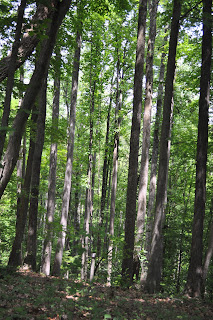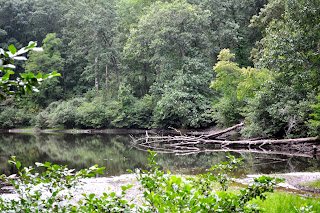Wahkeena Nature Reserve, Sugar Grove, Fairfield, Co., Ohio
Although I live fifteen minutes away, I visited Wahkeena for
the first time on August 2, 2012 with botanists seeking the many ferns and fern
allies that thrive here. I knew immediately that this would become a frequent
haunt. The trails are well-maintained and offer a great variety of flora.
Water Shamrock (Marsilea quadrifolia)
I started at Odonta Lake to visit the Eurasian Water Clover or
Water Shamrock (Marsilea quadrifolia).
This is an invasive exotic, but it is fascinating to learn that it is a fern!
It looks like clover growing in the shallow water. There are more than fifty
species of Water Clovers, but this is the only one established in Ohio. It was
deliberately introduced to a Connecticut Lake in 1862. It is now widespread in
New England and Central North America.
The four ‘clover leaves’ are actually fern pinnae. They are
actually the tip of the frond, beneath the water there many small pinnae. I
will try to get a picture of the plant underwater next time. We always think of
fern fronds as tapering at the tip, but this is very different!
Adult female Widow Skimmer (Libullula luctuosa)
The lakeshore is a dense habitat for flora and fauna. I saw
many Widow Skimmer dragon flies (Libullula
luctuosa). They are easy to identify by the saddlebag markings on their
wings. So far I have not had good luck shooting dragonflies, but the photo
above is clear enough to show the wing patterns. Unlike bees and butterflies, dragonflies
don’t stop to feed on nectar. They are fierce predators, moving swiftly to
pounce on unwary insects.
White Water Lily (Nymphaea
odorata)
Waterlilies fascinate people the world over. Most people who
go to the expense of installing and maintaining a water garden, place water
lilies at the top of the list of plants they wish to grow. Here at Wahkeena,
the waterlilies thrive. Their botanical specific epithet (the second word in
the botanical “Latin” name) is odorata,
meaning fragrant. I wonder what they smell like? Perhaps some time I can borrow
some waders and get the Director’ permission to wade out and smell one?
Dodder (Cuscuta
sp.)
The dodder is the orange string lying on the plants. Also
known by its genus Cuscuta, it is considered a noxious weed around the world.
People who have come into contact
with it need to wash their clothing before planting seed. The Cuscuta use
volatile organic compounds to identify their preferred hosts. It is not
possible to identify individual Cuscuta species in Ohio in the field.
Blunt-lobed Woodsia (Woodsia
obtusa)*
Woodsia are Cliff Ferns; not surprisingly they like to grow
in rock crevices. They can be confused Cystopteris ferns, if not examined
carefully with a magnifier. I have not seen this fern, growing from a crack in
the back stairs of the Nature Center at Wahkeena, anywhere else. It was the
only specimen pointed out to us during my four-day fern course. Perhaps once I
learn it better, I will see it all over the place?
Then I joined a walk led by Tom, the Preserve’s Director. We started by the Casa Burro Trail, named for the small barn, once home to burros, that it overlooks.
American Chestnut (Castanea
dentata)
American Chestnut was the giant of our forests until the
chestnut blight (a fungus introduced by insects) destroyed it. So I was
surprised to be shown
One at Wahkeena. It seems that Chestnuts still spring up in
the forest from old seeds of logs. The saplings grow vigorously until their
bark in compromised, allowing insects carrying the fungus to infect them.
Not far away we found Chestnut Oaks. They are not related to
chestnuts, but as you can see from the leaves shown here, they are similar to
those of the chestnut. They are not sharp and pointy like most oaks. Having
seen the two so close together, I think I will be able to identify them in
future!
Turkey Tail Fungus (Trametes
versicolor)
Eared fungae are often found on dead tree trunks. The Turkey
Tail Fungus is very common and displays a wide range of coloration. Any green
is actually algae growing on the fungus! T. versicolor is recognized as a medicinal mushroom in Chinese medicine under the name yun zhi.
In China and Japan T. versicolor is used as in immunoadjuvant therapy for cancer. It also has
potential for bioremediation, as it biodegrades certain toxins. A remarkable
organism commonly found in lowly places!
Oak Forest Behind
As we crested the hill, Tome bade us look back and then
ahead again. On either side of the ridge, the vegetation were quite different.
Behind we saw the thick and slightly disorderly forest dominated by oaks. Ahead
the arrow-straight trunks of Tulip trees (Liriodendren
tulipifera).
Tulip trees (Liriodendren tulipifera)
Broad Beech Fern (Phegopteris
hexanoptera)
Broad Beech Fern thrives here. Note how the pinnae are attached directly to the rachis (stem). There is no costa (stem) between the rachis and the first pinnae.
One of the group spotted a bright blaze of red off the
trail, where we found the bright red berries of the Jack-in-the-Pulpit. At this
time of year the foliage has faded away, but the brilliant berries attract
diners who may carry the seeds away.
We briefly enjoyed the company of this intrepid Stag! He has been making a nuisance of himself around the preserve.
Green Stain (Chlorociboria
aeruginascens) syn Elf Cap Fungus
This blue-green fungus appears as a stain on rotting wood.
The tiny fruiting bodies look like elf caps.
Fern Moss (Thuidium
delicatulum)
Fern moss does indeed look like tiny fern fronds. It is
commonly found in moist areas. I am a beginning student of mosses. The red strands are the sporophytes or fruiting bodies.
Black Cherry (Prunus serotina)
Black Cherry has distinctive dark, shaggy bark. I have quite
a lot of Amish-made,cherry furniture, hard, dense and finely textured. The leaves contain
cyanide and are poisonous.
Royal Fern (Osmunda
regalis)
The Royal Fern is quite distinctive as the non-fertile
pinnae (seen here) are simple and the fertile pinnae are very lacy. It loves
damp areas in acid soils.
Interrupted Fern (Osmunda
claytoniana)
The Interrupted Fern is named for a gap in the pinnae on
fertile fronds. None of which are to be seen here. This is one reason I find
fern identification frustrating at times: not all fronds are fertile and the
fertile fronds are most distinctive. The spores on their undersides gather
together to create sori which are distinctively shaped and placed on the
pinnae.
Thallose Liverwort (Marchantia
polymorpha)
Liverworts are another world of botany that I am just
beginning to explore. They are rife in my damp shady Hocking Hills terrain.
These Marchantia grow on the lip of a basin fed by a spring.
Marginal Wood Fern (Dropteris
marginalis)
This is an example of fern identification. Look at the shape and location of the sori, located at the edges of
the pinnae.
In under two hours I learned a staggering amount about the
flora of my area. I take photos and have begun to write about my walks to help
me to remember it all, or even a small part of it. I recently read someone
describe our initial views of the forest as ‘green wallpaper’. Indeed the
wealth of life in even a square foot of forest is intimidating. For the
amateur, I recommend choosing one type of plant to learn: trees, wildflowers,
mushrooms, ferns etc. These soon lead to other associated plants, etc.
To see my photos in better resolution: http://www.flickr.com/photos/vbergesen/
Other species I identified: Poison Ivy (Toxicodendron radicans), Spice Bush (Lindera benzoin), Greenbriar (Smilax
rotundifolia), Sassafras (Sassafras
albidum), Indian Tobacco (Lobelia
inflata), American Beech (Fagus
grandifolia), Tick Trefoil (Desmodium
spp.), Partidge Berry (Mitchella repens),
Dissected Wood Fern (Botrychium dissectum),
Shining Club Moss (Huperzia lucidulum),
Obedient Plant (Physostegia virginiana),
Mad-dog Skullcap (Scutellaria laterifolia),
Great Lobelia (Lobelia siphilitaca), Cardinal
Flower (Lobelia cardinalis)
BIBLIOGRAPHY
Links:
http://en.wikipedia.org/wiki/Fern
is a good overall article about ferns
http://hardyfernlibrary.com/ferns/illustratedGlossary.cfm
Just click on the
term and you
will see a clear diagram with labeled parts. Great
resource!
http://plants.usda.gov/java/profile?symbol=CUSCU
Shows the spread of
Cuscutus and
lists the states that consider it noxious.
http://en.wikipedia.org/wiki/Cuscuta
This is a great summary, explaining
how
devastating this parasite can be.
Explains why
it is difficult to identify individual Cuscuta species.
http://en.wikipedia.org/wiki/Trametes_versicolor
A useful article about
Turkey Tail
Fungus.
Books:
Clements, Steven & Carol Gracie. Wildflowers in the Field & Forest: A Field
Guide to the
Northeastern United States. Oxford University Press, NY,
2006.
Cobb, Boughton, Elizabeth Farnsworth, & Cheryl Lowe. Ferns of
Northeastern
and Central North America (Peterson Field Guides), 2nd
edn,
Houghton Mifflin, NY, 2005. Great reference guide that includes
fern allies.
Hallowell, Anne C. & Barbara G. Fern Finder. Nature Study Guild Publishers,
Rochester,
NY, 2001. The book to keep in your back pocket!*
Henn, Robert L. Wild
Flowers of Ohio, 2nd edn. Indiana University Press,
Bloomington,
IN, 2008.
Mead, Kurt. Dragonflies
of the North Woods. Kollath + Stensaas Publishing,
Duluth, MN,
2009.
Munch,
Susan. Outstanding Mosses &
Liverworts of Pennsylvania & Nearby
States. Albright College, 2006.*
Newcomb,
Lawrence. Wildflower Guide. Little,
Brown & Co., Boston, 1977.
Symonds,
George W. D. The Shrub Identification
Book. Harper Collins, NY,
1963.
The Tree Identification Book. Harper
Collins, NY, 2003.
*Available
for sale at the Wahkeena Nature Center.





